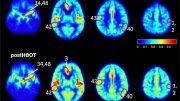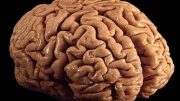
Scientists scanned the brains of children watching funny videos to examine which of their brain regions are active as their sense of humor develops.
Researchers at the Stanford School of Medicine examined which brain regions were active as children watched funny videos. Through the use of a functional magnetic resonance imaging scanner, doctors hoped to gain a better understanding of how positive emotions could affect a child’s well-being. Early findings suggest that the network that responds to humorous stimuli in adults is already present in kids, but is not as well-developed.
For the first time, researchers have scanned the brains of children watching funny videos to examine which of their brain regions are active as their sense of humor develops. The new findings from the Stanford University School of Medicine show that some parts of the brain network that respond to humor in adults already exist in 6- to 12-year-olds, though the neural circuits become more sophisticated as kids grow.
The researchers hope the work will provide a base for understanding how positive emotions, such as a sense of humor, could affect a child’s well-being.

Allan Reiss, MD. Credit: Stanford School of Medicine
“Humor is a very important component of emotional health, maintaining relationships, developing cognitive function and perhaps even medical health,” said Allan Reiss, MD, who directs the Center for Interdisciplinary Brain Sciences Research at Stanford. Reiss is the senior author of a study describing the new findings, published February 1 in the Journal of Neuroscience.
As an important component of positive emotion, a strong sense of humor may help children to be more resilient, added Reiss, who is also a professor of psychiatry and behavioral sciences, of radiology and of pediatrics at Stanford and at Lucile Packard Children’s Hospital. “In particular, we think a balanced and consistent sense of humor may help children negotiate the difficult period of pre-adolescence and adolescence,” he said.
To study kids’ responses to humor, the research team analyzed brain scans collected while 15 children, aged 6 to 12, watched short video clips while in a functional magnetic resonance imaging, or fMRI, scanner. The children were of at least average intelligence and did not have any psychiatric or developmental problems. The videos, which had been evaluated by other kids, fell into three categories: funny, positive, and neutral. The “funny” videos, mostly taken from the TV program “America’s Funniest Home Videos,” were both funny and rewarding to watch. The “positive” videos were rewarding to watch but not funny. The “neutral” videos were neither rewarding nor funny. All of the videos could be understood without sophisticated language or reading skills.
“It was great fun to plan the study, though we couldn’t just find movie clips that we, the investigators, found funny — our sense of humor is not the same as a 9-year-old’s,” said Reiss. “So we had a separate group of kids rate the clips before we undertook the study.”
The study’s results showed that funny videos activated two regions of children’s brains — regions that are also activated in adults who are viewing humorous material. While watching funny videos, children had high activity at the temporal-occipital-parietal junction, a brain area that processes perceived incongruities. Unlike in adults, this region was activated on both sides of the children’s brains; in previous studies of adults responding to cartoon humor, activation was confined to the left side of the brain.
“Our new finding suggests that the network that responds to humorous stimuli in adults is already present in kids but is not as well-developed,” Reiss said.
Children, like adults, also responded to humor with activation in the brain’s mesolimbic regions, which process rewards. Reward-processing areas were more strongly activated in younger children than older kids, which might mean the response of the reward circuitry becomes more sophisticated as children mature; it also could suggest that the funny videos used in this study were more age-appropriate (and more rewarding) for younger kids, the researchers said.
The positive videos activated the reward-processing areas but not the parts of the brain that process incongruity. This result supports prior research in adults that suggests incongruity — a surprise for the brain — is a key part of making something funny.
The researchers plan to expand on their findings by conducting studies to examine if brain circuits underlying humor in boys and girls develop differently, and to learn how a sense of humor is tied to a child’s overall mental health and resilience.
For example, Reiss said, a better-developed sense of humor might help to protect a child against depression. But positive emotional states, such as the humor response, have scarcely been studied in kids, he added.
“Negative emotional states such as depression or anxiety are compelling to study, but you can’t completely understand why a child has emotional stability or instability until you look at both sides of the coin,” he said. “This work is setting the stage for helping us look at how humor predicts resilience and well-being.”
Reiss’ team included the study’s first author, Michelle Neely, who was an undergraduate researcher at Stanford when the study was conducted and is now a medical student at Cornell; and postdoctoral scholars Elizabeth Walter, PhD, and Jessica Black, PhD, who is now a member of the faculty of Boston College.









Be the first to comment on "Researchers Use fMRI to Study How Humor Activates Kids’ Brain Regions"